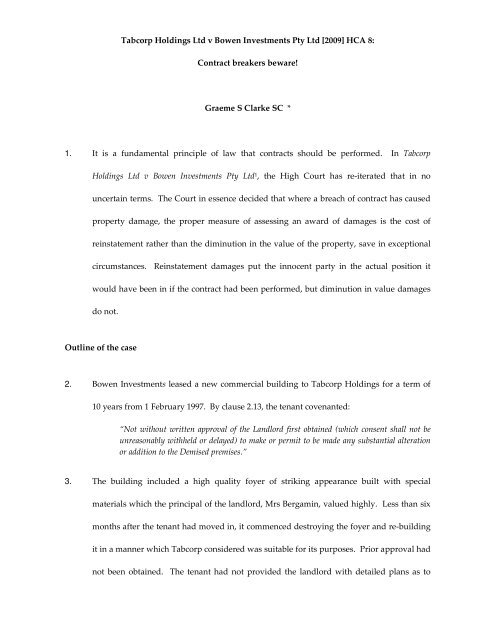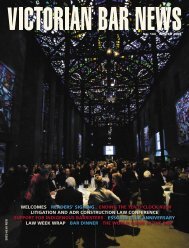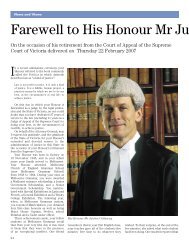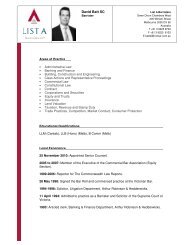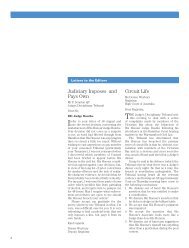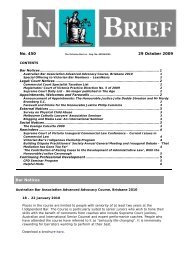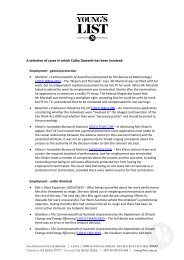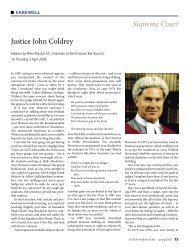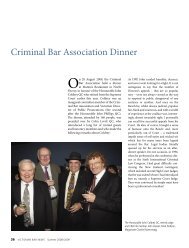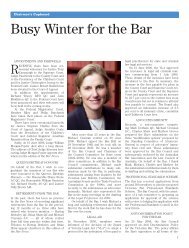Tabcorp Holdings Ltd v Bowen Investments Pty Ltd ... - Victorian Bar
Tabcorp Holdings Ltd v Bowen Investments Pty Ltd ... - Victorian Bar
Tabcorp Holdings Ltd v Bowen Investments Pty Ltd ... - Victorian Bar
Create successful ePaper yourself
Turn your PDF publications into a flip-book with our unique Google optimized e-Paper software.
<strong>Tabcorp</strong> <strong>Holdings</strong> <strong>Ltd</strong> v <strong>Bowen</strong> <strong>Investments</strong> <strong>Pty</strong> <strong>Ltd</strong> [2009] HCA 8:Contract breakers beware!Graeme S Clarke SC *1. It is a fundamental principle of law that contracts should be performed. In <strong>Tabcorp</strong><strong>Holdings</strong> <strong>Ltd</strong> v <strong>Bowen</strong> <strong>Investments</strong> <strong>Pty</strong> <strong>Ltd</strong> 1 , the High Court has re-iterated that in nouncertain terms. The Court in essence decided that where a breach of contract has causedproperty damage, the proper measure of assessing an award of damages is the cost ofreinstatement rather than the diminution in the value of the property, save in exceptionalcircumstances. Reinstatement damages put the innocent party in the actual position itwould have been in if the contract had been performed, but diminution in value damagesdo not.Outline of the case2. <strong>Bowen</strong> <strong>Investments</strong> leased a new commercial building to <strong>Tabcorp</strong> <strong>Holdings</strong> for a term of10 years from 1 February 1997. By clause 2.13, the tenant covenanted:“Not without written approval of the Landlord first obtained (which consent shall not beunreasonably withheld or delayed) to make or permit to be made any substantial alterationor addition to the Demised premises.”3. The building included a high quality foyer of striking appearance built with specialmaterials which the principal of the landlord, Mrs Bergamin, valued highly. Less than sixmonths after the tenant had moved in, it commenced destroying the foyer and re-buildingit in a manner which <strong>Tabcorp</strong> considered was suitable for its purposes. Prior approval hadnot been obtained. The tenant had not provided the landlord with detailed plans as to
2what changes it proposed. The landlord discovered that the works had begun a few dayslater. It was too late to obtain an injunction as the damage had been done. Almost all ofthe original surfaces of the foyer had been stripped. The landlord was confronted with afait accompli. The landlord considered the new foyer to be of inferior quality and wouldnot have consented to it being introduced by the tenant.4. The trial judge in the Federal Court, Tracey J 2 , found that the tenant in commencing, andthen completing, the destruction and re-building of the foyer had acted in breach of clause2.13 of the lease. Substantial alterations to the demised premises had been made withoutthe landlord’s permission. As to damages, the issue at the trial was whether they shouldbe assessed to be the diminution in value of the reversion as the tenant contended, or thecost of restoring the foyer of the building to its original condition as the landlord argued.The landlord had erected and leased the building for commercial purposes. It was aninvestment property. Tracey J held that there would be little if any diminution in the valueof the property at the end of the tenancy which the tenant’s re-building of the foyer wouldcause, save as to a small reduction in the net lettable area of the building. Tracey J assesseddamages at $33,820 being the cost of restoring the lettable area to its original size, and$1,000 nominal damages for the tenant’s breach of clause 2.13. The judge rejected thelandlord’s claim of $1.38 million, comprising $580,000 for the cost of reinstatement of thefoyer to its original condition and $800,000 for loss of four months rent while that workwas performed. 35. A Full Court (Finkelstein, Gordon and Rares J) 4 upheld the landlord’s appeal and awardedit the $1.38 million sought at trial.The High Court (French CJ, Gummow, Heydon,Crennan and Kiefel JJ) dismissed <strong>Tabcorp</strong>’s appeal.
36. The difference between $1.38 million and $33,820, self-evidently, is very considerable. Thekey argument made by the tenant in the High Court was that the disproportion betweenthe two figures assessed on the different bases was such as to make an award ofreinstatement damages unreasonable, and that accordingly the landlord ought be confinedto the small diminution in value of the commercial property which had been caused by thebreach. 5 The landlord’s loss was only the diminution in value. The tenant argued thatdamages were compensatory in nature, not punitive, and that the landlord was not to beput in a better position than if the breach had not occurred. In the tenant’s submission,that would occur if reinstatement damages were awarded as the trial judge had found thatwhen possession would be delivered up to the landlord, the foyer would needrefurbishment in any event to take account of architectural developments and the need to“freshen up” the building. 67. These arguments found no favour with the High Court. The Court held that as the foyerwould have remained unaltered if the tenant had not breached the lease, the appropriatemeasure of damages was reinstatement damages because only an award of such damageswould put the landlord in the position that it would have been in had the lease beenperformed. 7 The disproportion between $1.38 million and $33,820 was accorded limitedsignificance, much less a decisive weight. As to that, the Court simply stated, “…therequirement of reasonableness did not mean that any excess over the amount recoverableon a diminution in value was unreasonable”. 88. It was the landlord’s building and <strong>Bowen</strong> <strong>Investments</strong> was entitled to have the foyer itwanted in its building. Diminution in value damages would not achieve that, but wouldleave the building with the foyer the tenant wanted, not the foyer that the landlord
4wanted. As the landlord argued, it had lost its foyer. Damages to compensate for that losswere not to be confined to one measure of pecuniary loss: diminution in value damages, asthe tenant contended.9. All damages decisions depend on the evidence. However here the correct measure ofdamages was decided by the High Court as a matter of principle and accordingly itsdecision is important in its application to subsequent cases. I suggest further that theCourt’s reasoning merits careful consideration because:• The disproportion between the two competing measures of assessment of damages wasso considerable, which prima facie strongly supported the tenant’s contention.• None of the four judges who decided the case in the Federal Court considered theprinciples on the basis of which the High Court made its decision; the High Courtdecided the case afresh.• Although the High Court’s reasoning at first blush appears conventional, on analysis itrepresents a considerable shift in the Court’s position on the assessment of damages inproperty damage cases against the interests of the contract breaker, and in favour of theinterests of the innocent plaintiff.The case in more detail10. It is necessary to elaborate on the facts and the course of the proceeding.• Clause 2.10 obliged the tenant to maintain repair and keep the whole of the demisedpremises in good and substantial repair, working order and condition.
5• Clause 2.11 provided that at the expiration of the lease the tenant was obliged tosurrender and yield to the landlord the whole of the demised premises in good andtenantable repair.• The landlord at trial did not allege breach of the clause 2.10 maintenance and repairclause, only breach of the clause 2.13 negative obligation not to make unauthorisedalterations.• The lease did not contain a provision obliging the tenant to make good or reinstate inthe event that unauthorised alterations had been made.• The landlord at trial argued that the lease should be rectified to include a make goodclause based on a prior heads of agreement, but Tracey J rejected that claim. 9 Noappeal was brought by the landlord in relation to that.• As a result of the unauthorised alterations in July and August 1997, the landlord couldhave forfeited the lease 10 , re-taken possession and reinstated the foyer, but it did not doso. The landlord’s solicitors alleged breach by the tenant of clause 2.13 and requiredreinstatement.By mid-1998 issue had been joined, but no proceedings were thenissued. The tenant remained in possession and continued to pay the rent.• In 2004 in the course of a market rent review, the dispute about the foyer revived. ByApril 2006 the lease was renewed early from 1 February 2006 until 31 January 2012,with a further option to renew for five years until 2017. <strong>Bowen</strong> <strong>Investments</strong> hadcommenced the proceeding on 30 September 2005. At that time the term of the leasewas not due to expire until 31 January 2007. At the time of the 2006 renewal, it wasexpressly agreed that nothing in the renewed lease should be construed as affecting,limiting or compromising the proceeding in any way. 11
6• The trial judge found that the relevant representative of the tenant had been well awareof the need to obtain the landlord’s consent to its proposed alterations and knew thatconsent had not been provided. Notwithstanding that, the tenant went ahead andmade the alterations. Tracey J considered this to be a contumelious disregard for thelandlord’s rights. 12 The tenant did not challenge that finding on appeal.• It was common ground at trial that reinstatement by the landlord could not occur priorto the conclusion of <strong>Tabcorp</strong>’s tenancy in 2012 or 2017 as the tenant would remain inpossession. 13• The tenant at no time offered to reinstate the foyer to its original condition at theconclusion of the tenancy. 14• The landlord’s evidence was that the premises would be reinstated at the end of<strong>Tabcorp</strong>’s tenancy, and that evidence was not challenged at trial by the tenant. 15• The trial judge found that it was likely that at that time refurbishment of the foyerwould be necessary. 16• The evidence at trial concerning the cost of reinstatement was in 2004 or 2006 dollars. 17• At trial the tenant did not run an alternative argument, or lead evidence, to the effectthat if reinstatement damages were to be awarded any, or any particular discount, forbetterment ought be made. That possibility was referred to by the landlord at trial andin the Full Court, but the tenant did not pursue it. 18• Although the damage alleged to be in breach of the clause 2.13 covenant in the leaseoccurred in mid-1997 and the proceeding was not commenced until September 2005,the tenant accepted that no limitation issue arose because the lease was made by deed,therefore attracting a fifteen year limitation period. 19
711. In these circumstances, any commercial lawyer’s inclination would be to favour thelandlord’s position. It had been subjected by the tenant to a deliberate and serious breachof the lease. Prima facie, the tenant should pay the landlord sufficient to make good thebreach. However, is it reasonable for the tenant to be required to pay reinstatementdamages of $1.38 million, rather than diminution in value damages of $33,820, when theproperty was a commercial property which would require refurbishment in 2012 or 2017 inany event even if the tenant had not changed the foyer at all? <strong>Tabcorp</strong>’s foyer would notbe significantly less attractive to prospective tenants than the landlord’s original foyer. Thelandlord was paid the same rental under the original lease, and would continue to be paidrental through the term/s of the renewed lease.12. All four Federal Court judges referred to an English Court of Appeal decision, Joyner vWeeks [1891] 2 QB 31, which received subsequent High Court approval in Graham v MarketsHotel <strong>Pty</strong> <strong>Ltd</strong> (1943) 67 CLR 567. Those cases concerned breach of a covenant in a lease tomaintain the premises in good repair. Clause 2.10 was such a clause. The rule establishedby Joyner v Weeks, according to Finkelstein and Gordon JJ, 20 was that the landlord is entitledto recover the cost of repairs, including loss of rental during performance of work, if theaction for damages for breach of the covenant was brought at or near the termination of thelease.13. Tracey J in rejecting the landlord’s claim for reinstatement damages, reasoned:“In some cases it may be appropriate to award damages on the basis contended for by theapplicant. This will be so in a relatively narrow range of cases where a tenant has sodamaged or modified premises that they are unlettable at the conclusion on the lease: seeJoyner v Weeks [1891] 2 QB 31. Normally, however, reinstatement costs will not beawarded unless there exists some special interest in reinstatement arising from a radicalchange to the usage to which the property can be put following renovations by the tenant:see Evans v Balog [1976] 1 NSWLR 36.
8The weight of the expert evidence called in the present case supports the conclusion that, atthe end of <strong>Tabcorp</strong>’s lease, whether that occurs in 2012 or 2017, there will be little, if any,diminution in value of the premises occasioned by <strong>Tabcorp</strong>’s renovation of the foyer. Whilethere may be different views as to the aesthetic values of the former foyer and that installedby <strong>Tabcorp</strong>, <strong>Tabcorp</strong>’s works have not occasioned any significant loss of value to thebuilding. Furthermore, extensive renovation of the foyer would, according to the evidence,be necessary at the end of the lease.” 2114. Joyner v Weeks had not been cited to Tracey J. 22 Counsel for both parties had referred toBellgrove v Eldridge (1954) 90 CLR 613 at trial. 2315. Finkelstein and Gordon JJ held that repair covenant cases illustrated by Joyner v Weeks wereapplicable, because the negative covenant in clause 2.13 not to make unauthorisedalterations in effect was the same obligation as a positive repair covenant such as clause2.10, but disagreed with Tracey J as to their application. Although the tenant wouldremain in possession until 2012 or 2017, the provision in 2006 agreement that the newlease would not affect the proceeding meant that it was appropriate that reinstatementdamages under Joyner v Weeks should be awarded. 2416. Rares J held that clause 2.10 applied, but was confronted with the difficulty that breach ofthat clause had never been alleged. Rares J would have awarded reinstatement damages,together with Finkelstein and Gordon JJ, but allowed further submissions as to theprocedural consequences. 25In the High Court17. In the High Court, the tenant argued that:• The clause 2.13 negative obligation not to alter without the landlord’s consent, whichwas the only breach relied on, was not the same as a clause 2.10 positive obligation to
9repair. Joyner v Weeks related to such a repair covenant and so had no applicationhere. 26• In any event, Joyner v Weeks did not apply because the initial lease was not at an endbut had been renewed. Clause 2.10 had no application because the altered foyer was ingood repair. 27• If Joyner v Weeks applied, it was wrongly decided and ought be overruled. Thecommon law rule had been affected by legislative provisions in other States, but not inVictoria, to the effect that reinstatement damages could not be awarded if theyexceeded the diminution in value of the reversion at the expiry of the lease. 28 Anaward of reinstatement damages would be unjust. 29• General damages for breach of contract authorities applied, particularly Bellgrove vEldridge in the High Court, with the result that diminution in value damages ought beawarded because the landlord had failed to demonstrate on the evidence, and on thefindings of the trial judge, that it was necessary and reasonable for reinstatementdamages to be awarded. 30 The landlord’s loss was only the small diminution in thevalue of the reversion.18. During the course of argument in the High Court, it became apparent there was no need todecide the correctness of Joyner v Weeks if it had no application, which left open thepossibility that general contractual principles could be applied to decide the case. 31 This iswhat the High Court did. The Court found it unnecessary to decide anything concerningclause 2.10, or Joyner v Weeks issues.19. The tenant argued that Bellgrove v Eldridge, a building contracts case, applied and that itsapplication resulted in diminution in value damages being awarded on the uncontested
10factual findings made by the trial judge as to that. 32 The landlord noted that Bellgrove vEldridge concerned a different type of contract, which it obviously did. However, <strong>Bowen</strong><strong>Investments</strong> argued that Bellgrove v Eldridge did apply in respect of the breach of the clause2.13 covenant of the lease, but with the opposite result that reinstatement damages shouldbe awarded. 3320. The High Court decided that Bellgrove v Eldridge applied, but the surprise in the decisionfor <strong>Tabcorp</strong> was that that meant reinstatement damages ought be awarded, contrary to itssubmission, rather than diminution in value damages.21. In Bellgrove v Eldridge, a builder who had built a house for a client which containeddefective concrete and mortar, contended that the measure of damages was limited to thediminution in value of the property and did not extend to the cost of rectification. TheHigh Court rejected the builder’s contention, holding that the landowner’s loss prima faciecould only be measured by the cost of reinstatement. 3422. The High Court in <strong>Tabcorp</strong> <strong>Holdings</strong> v <strong>Bowen</strong> <strong>Investments</strong>, in reference to that holding,stated:“So here, the Landlord was contractually entitled to the preservation of the premiseswithout alterations not consented to; its measure of damages is the loss sustained by thefailure of the Tenant to perform that obligation; and that loss is the cost of restoring thepremises to the condition in which they would have been if the obligation had not beenbreached.” 3523. The Court continued 36 and referred to a further passage in Bellgrove v Eldridge, stressed bythe tenant, that:“The qualification … is that, not only must the work undertaken be necessary to produceconformity, but that also, it must be a reasonable course to adopt.”
1124. The High Court elaborated on this as follows: 37“Further, the Landlord correctly submitted that the Tenant’s submission misconstruedwhat this Court said in Bellgrove v Eldridge. The “qualification” in the passage quotedabove that the ‘work undertaken be necessary to produce conformity’ meant, in that case, aptto conform with the plans and specifications which had not been conformed with. Applied tothis case, the expression ‘necessary to produce conformity’ means ‘apt to bring aboutconformity between the foyer as it would become after the damages had been spent inrebuilding it and the foyer as it was at the start of the lease.’ And the Landlord alsocorrectly submitted that the requirement of reasonableness did not mean that any excessover the amount recoverable on a diminution in value was unreasonable. The Tenant’ssubmissions rested on a loose principle of “reasonableness” which would radically undercutthe bargain which the innocent party had contracted for and make it very difficult todetermine in any particular case on what basis damages would be assessed. That principleshould not be accepted.If the benefit of the covenant in cl 2.13 were to be secured to the Landlord, it is necessarythat reinstatement damages be paid, and it is not unreasonable for the Landlord to insist ontheir payment.”25. The Bellgrove v Eldridge “qualification” to the “prima facie” measure of reinstatementdamages had become a two-fold exception to a stronger general rule that reinstatementdamages rather than diminution in value damages is the correct measure. The exception iswhether:• It is necessary for reinstatement damages to be paid in order for the plaintiff to havethe benefit of performance of the contract.• It is not unreasonable for the plaintiff to insist upon payment of reinstatementdamages.26. The High Court explained that the test of “unreasonableness” will only be satisfied in“fairly exceptional”, 38 or “quite exceptional” 39 circumstances.Two examples ofunreasonableness were given:
12• In a building contract for a cement rendered house using second-hand bricks, wherethe builder used first quality bricks instead. 40 Demolition of the house and use ofsecond-hand bricks in accordance with the contract would be unreasonable.• In a building contract for a swimming pool 7 feet 6 inches deep where the depth of thepool as built was only 6 feet, where there was no diminution of value and it was notclear that the plaintiff intended to demolish the pool and reconstruct a new one ifreinstatement damages were awarded. 41It would be unreasonable to awardreinstatement damages in such circumstances.27. The decisive issue is whether the innocent plaintiff was using a technical breach to securean uncovenanted profit. 42 That was not the case here. The landlord just wanted its originalfoyer back. There was nothing unnecessary or unreasonable about that, the Court held.Analysis28. While it is trite law that general contractual principles apply to leases, 43 the High Court hadno hesitation in putting Joyner v Weeks landlord and tenant issues to one side and applyingBellgrove v Eldridge directly.29. There was no difficulty in the Court applying damages principles decided in the context ofbreach of building contracts, to breach of a lease. No significance was placed upon theclause 2.13 obligation being a negative one, whereas in a building contract dispute there isa positive obligation to perform which is breached. It did not matter that there was noexpress clause in the lease calling for reinstatement by the tenant in the event ofunauthorised alterations.
1330. I suggest that it did matter that the tenant’s breach was deliberate. The High Courtreiterated the trial judge’s finding that the tenant’s breach involved a “contumeliousdisregard” for the tenant’s rights. 44 The Court also stated:“The clandestine conduct of the Tenant made it impossible for the Landlord to apply for aninterlocutory negative injunction, but that does not detract from that aspect of cl 2.13 inassessing damages for its breach”. 4531. The manner in which the nature of the tenant’s breach was taken into account, as reflectedin the Court’s reasons, is perhaps indicated by exchanges between bench and bar duringthe course of argument. Gummow J stated that exemplary damages were not in point asthe damages sought were for a breach of contract, but that the special nature of the foyer,in the landlord’s view, was known to the tenant could be considered. French CJ stated thatit might not be so much a case of punishing contumelious conduct, as not rewarding it. 4632. The Court plainly did take account of Mrs Bergamin’s evidence that the landlord intendedto reinstate, although the Court did not emphasise that. Rather, that evidence was thebasis of the great significance which the Court placed on requiring the contract to beperformed. Performance was what the landlord wanted: to have damages assessed on abasis as though the contract had been performed, and to achieve such performance in factby reinstating the foyer. The Court held that the landlord was entitled to that.33. It should be noted that, as in all common law damages awards concerning future matters,it is beside the point that the landlord’s circumstances might change (eg. if it decided to sellthe building subject to the renewed lease, without reinstatement of the foyer). 47 Neither theparties nor the Court referred to this.
1434. The tenant in the High Court accepted that the personal preferences of the landlord as toreinstatement were to be taken into account, but contended that such preferences hadwrongly been treated by the Full Court as decisive. The disproportion between the twomeasures of assessment of damages demonstrated the unreasonableness of awardingreinstatement damages.Reliance was placed upon the swimming pool case, RuxleyElectronics and Construction <strong>Ltd</strong> v Forsyth in that regard. 48 However, the High Court in effectheld that the disproportion was no answer to the importance of enforcing contractualperformance, which nonetheless required that an award of reinstatement damages in lieuof performance be made.The issue was not, as the tenant submitted, 49 whetherreinstatement damages are a reasonable measure of loss compared with the diminution invalue of the property caused by the breach. Such an approach would give insufficientweight to securing to the innocent party the tenant’s promised performance.35. The Court reiterated, 50 but also explained, the familiar ruling principle regarding damagesat common law for breach of contract. Parke B in Robinson v Harman (1848) 1 Exch 850 at855, 154 ER 363 at 365, stated:“The rule of the common law is, that where a party sustains a loss by reason of a breach ofcontract, he is, so far as money can do it, to be placed in the same situation, with respect todamages, as if the contract had been performed.”36. Importantly, the Court held that regarding a covenant such as clause 2.13, “…it is not thecase that, in Oliver J’s words (in Radford v De Froberville) 51 that:‘the disappointment of the plaintiff’s hopes and expectations from the contract becomes arelevant consideration only so far as it is measurable either by some deterioration of theplaintiff’s financial situation or by some failure to obtain an amelioration of his financialsituation.’
15To reason otherwise is to undermine a fundamental postulate inherent in cl 2.13.” 52(emphases supplied).37. In other words, it was not just about money. The landlord was entitled to have its foyerback regardless of whether the market, or the tenant, valued it as highly as the landlorddid.I suggest that the Court’s emphasis on the due performance of contractualobligations, not unreasonably insisted upon by the innocent plaintiff, is the reason why thetenant’s disproportion argument was rejected, and was rightly rejected.38. Each party to a contract is reasonably entitled to expect that the other party’s agreedperformance is what it will receive in exchange for its own performance. That can be justabout money, as in a cash sale of goods.39. However, conduct to which the parties have not allocated a particular price is often part ofthe exchange, especially where performance is to occur over time. In the event of nonperformance,the market price of non-performance (here diminution in the value of theproperty) is an inadequate measure of the value to the innocent party of the promisedperformance where an award of damages can rectify the breach.40. The High Court stated that:“Underlying the Tenant’s submission that the appropriate measure of damages was thediminution in the value of the reversion was an assumption that anyone who enters into acontract is at complete liberty to break it provided damages adequate to compensate theinnocent party are paid.” 5341. The Court rejected that assumption, emphasising the existence of equitable remedies suchas specific performance and injunctions to ensure or encourage the performance ofcontracts, rather than the payment of damages for breach. 54
1642. A potentially troubling aspect of the Court’s decision is the fact that the landlord wouldnot re-take possession until 2012 or 2017, by which time refurbishment of the foyer wouldbe required even if the tenant had not altered the foyer at all. Would not the landlord beovercompensated by being in a position to have a new foyer in 2012 or 2017, rather thanhaving an old one in need of refurbishment?43. It is important to highlight the High Court’s answer to the question. 55 Had the tenantcontended at trial that reinstatement damages should be reduced to some extent due to thebetterment for the landlord of new over old (cost of reinstatement less cost ofrefurbishment), and led evidence to quantify that, then a betterment reduction may (well) 56have been merited. However, the tenant did not do so. Hence no findings were made byTracey J which could have formed the basis of a betterment allowance in favour of thetenant. Accordingly, the disproportion between $1.38 million and $33,820 is perhaps not assignificant as first appears.44. In any event, the message from the Court is clear enough: Contract breakers beware!* LLB (Hons), LLM (Melb); BCL (Oxon). The paper was presented to members of the <strong>Victorian</strong> <strong>Bar</strong> on17 March 2009 as part of the <strong>Bar</strong>’s Continuing Legal Education program.
171[2009] HCA 8 (French CJ, Gummow, Heydon, Crennan and Kiefel JJ).2<strong>Bowen</strong> <strong>Investments</strong> <strong>Pty</strong> <strong>Ltd</strong> v <strong>Tabcorp</strong> <strong>Holdings</strong> <strong>Ltd</strong> [2007] FCA 708.3[2007] FCA 708 at paras [82], [90]-[103].4<strong>Bowen</strong> <strong>Investments</strong> <strong>Pty</strong> <strong>Ltd</strong> v <strong>Tabcorp</strong> <strong>Holdings</strong> <strong>Ltd</strong> (2008) 166 FCR 494; [2008] FCAFC 38.5Young QC, leading counsel for the landlord: [2008] HCA Trans 395 at pages 30, 31 and 36.6Young QC: [2008] HCA Trans 395 at pages 25, 26, 30 and 34; [2007] FCA 708 at para [102].7[2009] HCA 8 at para [15].8[2009] HCA 8 at para [19].9[2007] FCA 708 at paras [57]-[63].10Young QC: [2008] HCA Trans 395 at page 30;Bennett QC, leading counsel for the tenant: [2008] HCA Trans 395 at pages 48, 57.11[2007] FCA 708 at para [54].12[2007] FCA 708 at para [84].13[2007] FCA 708 at para [91].14Bennett QC: [2008] HCA Trans 395 at page 58.15(2008) 166 FCR 494 at paras [25], [27].16[2007] FCA 708 at para [102].17[2009] HCA 8 at para [26].18[2009] HCA 8 at paras [24], [25]; Bennett QC: HCA Trans 395 at page 52.19Young QC: HCA Trans 395 at pages 12, 25; Limitation of Actions Act 1958 (Vic) s. 5(3).20(2008) 166 FCR 494 at para [10].21[2007] FCA 708 at paras [92], [93].22Young QC: HCA Trans 395 at page 9.23Young QC: HCA Trans 395 at page 29.24(2008) 166 FCR 494 at paras [13], [24], [31].25(2008) 166 FCR 494 at paras [67], [68], [122]-[124].26Young QC: HCA Trans 395 at pages 13, 14.27Young QC: HCA Trans 395 at pages 13, 21.28Eg. Conveyancing Act 1919 (NSW) s 133A.29Young QC: HCA Trans 395 at pages 23, 24 and 25.30Young QC: HCA Trans 395 at pages 9, 16, 18 and 36.31Young QC: HCA Trans 395 at page 19, 23;Bennett QC: HCA Trans 395 at pages 41, 49, 50, 51 and 56.32Young QC: HCA Trans 395 at pages 16, 18 and 36.
1833Bennett QC: HCA Trans 395 at 55.34(1954) 90 CLR 613 at 617; Dixon CJ, Webb and Taylor JJ.35[2009] HCA 8 at para [15].36[2009] HCA 8 at para [17].37[2009] HCA 8 at paras [19], [20].38[2009] HCA 8 at para [17].39[2009] HCA 8 at para [18].40[2009] HCA 8 at para [17]; example provided by the High Court in Bellgrove v Eldridge (1954) 90 CLR613 at 618.41[2009] HCA 8 at para [18]; example provided by the House of Lords’ decision in Ruxley Electronicsand Construction <strong>Ltd</strong> v Forsyth [1996] AC 344 at 354-355.42[2009] HCA 8 at para [17], citing with approval Oliver J in Radford v De Froberville [1977] 1 WLR 1262at 1270; [1978] 1 All ER 33 at 42.43Progressive Mailing House <strong>Pty</strong> v Tabali <strong>Pty</strong> <strong>Ltd</strong> (1985) 157 CLR 17 at 29, 38, 51 and 56.44[2009] HCA 8 at para [4].45[2009] HCA 8 at para [12].46With Bennett QC: HCA Trans 395 at page 58.47Bellgrove v Eldridge (1954) 90 CLR 613 at 620; see generally Westpoint Management <strong>Ltd</strong> v ChocolateFactory Apartments <strong>Ltd</strong> [2007] NSWCA 253 at paras [50]-[62].48Young QC: HCA Trans 395 at pages 35, 36 and 37; Ruxley Electronics and Construction <strong>Ltd</strong> v Forsyth[1996] AC 344 at 354B, 358-359, 360-361, 365-366, 367 and 370-371.49Young QC: HCA Trans 395 at page 36.50[2009] HCA 8 at para [13]51[1977] 1 WLR 1262 at 1273; [1978] 1 All ER 33 at 44.52[2009] HCA 8 at para [14].53[2009] HCA 8 at para [13].54Ibid.55[2009] HCA 8 at paras [24], [25].56Bennett QC: HCA Trans 395 at pages 43, 52, conceded that a small betterment discount may havebeen appropriate, but that that was a matter for the tenant to argue.


